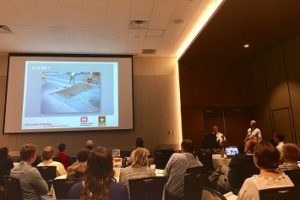At a packed classroom session at the StormCon 2017 Surface Water Quality Conference and Expo, Steve Thibaudeau of the U.S. Army Corps of Engineers and Kurt Schaefer of Stantec talked about their experiences with the analysis and repair of nonperforming stormwater management systems. The presentation, called “Diagnosing and Repairing a Stormwater Management System: The Good, The Bad, and the Ugly,” focused on a case study involving an Army Reserve project in the Seattle area, and sparked active interest from attendees.

Soon after the initial construction of the project in question was completed, the site began to have significant flooding and overflow issues in the parking lot and infiltration pond areas. After it was determined that the stormwater management system was not performing correctly, Thibaudeau and Schaefer were called in to figure out why.
Start with a Desktop Survey
In approaching the diagnosis of the stormwater management problems, Thibaudeau first focused on gathering information. He stressed that it is important to start with this “desktop survey” of malfunctioning systems by looking at background information like the geotechnical report, preliminary stormwater monitoring reports, and construction photos. It is also necessary to evaluate the system’s construction plans to confirm the as-built conditions and identify any redlines, or areas where the actual construction practices may have deviated from the original design.
In this case, reviewing the plans and the construction photos played a vital part in diagnosing the problems with the stormwater management system because they revealed issues with grading, the presence of compacted fill, and pre-existing issues with subsurface layers at the site.
Conduct Field Investigations
After the initial background investigation phase, Schaefer helped undertake the field exploration of the system components. By digging test pits, conducting comparative infiltration testing, and looking at the effectiveness of installed filtration cartridges, Schaefer and Thibaudeau eventually determined that due to the low permeability of the fill used in the infiltration pits and surrounding areas, the actual infiltration rates were anywhere from 3 to 25 times slower than what was used for the original design.
As a result, initial temporary fixes were put in place in the form of piping installed in the excavated test pits that connected to the infiltration basins. After about 3 years from the start of the investigation, final system repairs were successfully completed that expanded and excavated the existing infiltration basins, added new ones, and included more permeable fill. Because both the contractor and the designer were partially responsible for the original system failure, the expense of the repairs was shared between them.
Lessons Learned
By undertaking this two-pronged approach to stormwater management system diagnosis, Thibaudeau and Schaefer were able to pinpoint the causes of the extensive flooding and overflow issues and arrive at an effective solution for the system. Both speakers encouraged attendees to take an objective view of problem projects and not to make broad assumptions about system design and construction. They also recommended making sure that all design documents are well organized and coordinated, and suggested requiring additional testing of subgrade materials after they are exposed to make sure they are suitable for infiltration.
Finally, the speakers encouraged the stormwater professionals present to allow designers to have input during initial system construction. Not only will this allow contractors to understand the sensitive areas of a job site and the implications of temporary construction methods, but it will confirm that the field conditions match the intended design parameters. As a result, these expensive diagnostics and repairs will be avoided from the outset.
